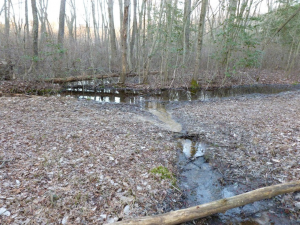One of the keys to managing freshwater ecosystems is knowing where and how rivers flow. Stream gauges provide that information, but they are located predominantly in large perennial, or constantly flowing, waterways. However, researchers at The University of Alabama suggest that focusing on non-perennial streams and rivers, or waterways that dry on a regular basis, provides critical information for water and natural resource management.
Dr. Nate Jones, assistant professor of ecohydrology in UA’s Department of Biological Sciences, is one of the authors of a paper recently published in the journal Nature that stresses the need for more stream gauges where water runs out.
“We often pay for stream gauges because there’s some sort of human need associated with them, such as predicting floods, monitoring drought and understanding ecosystems,” said Jones. “It’s important that we have those gauges, but we aren’t gauging in the non-perennial streams where over 60% of the river miles globally go dry on a regular basis.”
According to Jones, even 40% of Alabama’s streams dry up every year. That may come as a surprise because one-tenth of all freshwater in the United States begins or flows through the state, but it is a concern.
“We predict we’re going to see more and more drying here in the Southeast, and I think it’s going to play an important role in both water and ecosystem management,” he said. “We’re spending so much time studying these because we think that having actionable knowledge is going to be quite important within the next 30-40 years.”
While southeastern states are typically rich with water, the story is much different out west. Here in the Southeast, you can step across streams when they dry up. In the western U.S., entire rivers can disappear, causing water resource concerns for officials. Adding more stream gauges in the places that routinely lose water can help water managers determine how to more efficiently manage their supplies.
“When you’re in the more arid environments, the duration of that drying is really important,” Jones said. “People need to understand how long that tap will be turned off before they can get more water.”
From a water quality perspective, Jones compared intermittent streams to capillaries in the lungs. There are a lot of them, but because they’re so small, you might not think it’s a big deal if one becomes damaged. Together, though, they take up a lot of surface area where the gas exchange of oxygen and carbon dioxide occurs in the body.
“When you think about carbon and nitrogen fluxes in water, the small streams are like the capillaries of a river network,” he said. “They’re really the first place the carbon and nitrogen enter the stream network and start spiraling downstream.”
From a biological viewpoint, the disturbance regime, the drying and re-wetting of these non-perennial streams, plays an important role in partitioning the different types of species and the biodiversity of these environments.
The lack of gauges in intermittent streams is not only a problem that needs solving here in the U.S., but also around the world. Global stream gauge data is publicly available for researchers to use in models and forecasts. Extra gauges in low-flow areas will be beneficial because so much of the world’s freshwater originates in those locations.
“As an example, we know water and natural resource managers have to make decisions that balance multiple objectives,” said Jones. “By providing actionable information about non-perennial streams and rivers, we can help managers better optimize those decisions to improve downstream water quality and promote biodiversity while also balancing other competing objective associated with water quantity.”
Jones said their research highlights the need to address current gauge placement biases by investing in and prioritizing the installation of new gauging stations to increase accessibility of local and regional gauging data to support human responses to water challenges.
“We wanted to quantify the bias for the scientific community to understand where our gap in knowledge is and how it affects our understanding of hydrologic systems and ecosystems,” he said. “We can start to correct that through research grants, modeling and the like so that it’s no longer an ‘unknown’ unknown.”

